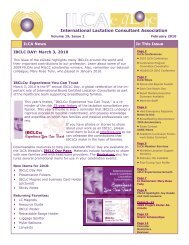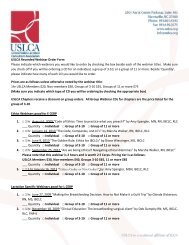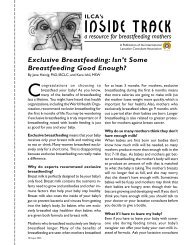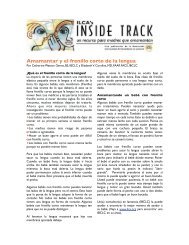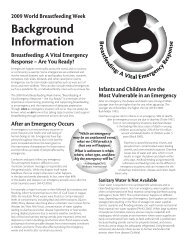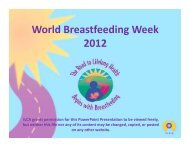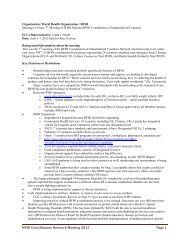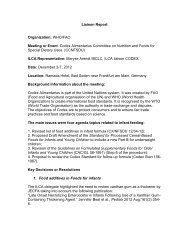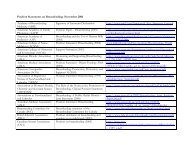2010 - International Lactation Consultant Association
2010 - International Lactation Consultant Association
2010 - International Lactation Consultant Association
Create successful ePaper yourself
Turn your PDF publications into a flip-book with our unique Google optimized e-Paper software.
3221 Conington Street<br />
West Lafayette, IN 47906<br />
765-494-4040; ahmedah@purdue.edu<br />
ABSTRACT<br />
Background: Studies in the past have found that nurses have inadequate knowledge about<br />
breastfeeding topics and suggested improvement in breastfeeding education.<br />
Objective: To assess the current breastfeeding knowledge of senior nursing students and to<br />
examine the variables associated with breastfeeding knowledge and skills.<br />
Method Design: An exploratory descriptive design. Subjects: A total of 115 senior nursing<br />
students from two different Midwestern universities filled out the questionnaire. Inclusion criteria<br />
included students who finished maternal/child nursing didactic and clinical courses, and were<br />
regular bachelor senior nursing students and second degree students. Instrument: A<br />
Breastfeeding Knowledge Questionnaire was adapted from Brodribb, Fallon, Jackson, and<br />
Hegney (2008). The questionnaire consisted of 24 items covering three main categories in<br />
including benefits of breastfeeding, physiology of lactation and feeding adequacy, breastfeeding<br />
skills including exclusive breastfeeding, maternal conditions that may affect breastfeeding, and<br />
common breastfeeding problems. Statistical Analysis: Two-tailed t test and Pearson correlation<br />
were used to test the differences in breastfeeding knowledge and the relationship between the<br />
knowledge categories.<br />
Results: Findings revealed a significant difference in the students’ knowledge regarding<br />
physiology and benefits (t = -3.615, p = .000) and benefits and skills (t = 5.255 and P = .000).<br />
There was also significant correlation between knowledge of physiology and benefits (r = 0. 241,<br />
p = .009) and benefits and skills (r = .027, p = .000).<br />
Conclusion: More strategies to improve breastfeeding education in nursing curriculum focusing<br />
on breastfeeding skills need to be addressed.<br />
THE BUTTERBALL TURKEY EFFECT: MATERNAL IV FLUIDS AND INFANT WEIGHT<br />
Robin Lynn Hirth, Med, BS, IBCLC; Tina Leigh Weitkamp, MSN, BSN<br />
Mercy Hospital Fairfield<br />
6085 Springdale Road<br />
Cincinnati, OH 45247<br />
513-870-7883; rlhirth@health-partners.org<br />
ABSTRACT<br />
Background: Health care providers use infant weight loss in the first few days of life as a<br />
measurement of effective feeding. Breastfeeding supplementation or increased formula feeds are<br />
often recommended with an infant weight loss of 7-10% of birth weight.<br />
Goal: This study goal was to examine if the amount of maternal IV fluids during labor affects<br />
average birth weight and subsequent weight loss of infants.<br />
Methods: The study was a retrospective review of medical records for mother/infant dyads.<br />
Study population was a random sample of 200 mothers/infant dyads delivering at one<br />
Midwestern hospital. Exclusion criteria for dyads included: conditions impacting health and<br />
weight of the infant, infants with birth weight 4000 gm, and/or infant gestational age<br />
42 weeks. A data collection tool was utilized to review medical records and record data.





